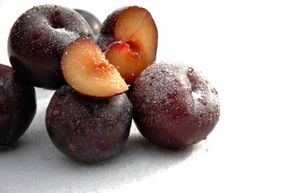If you have visions of sugar plums decorating your holiday table, there are a couple of options when deciding to make this Christmas treat.
Sugar Plums - A History
Advertisement
Sugar plums date to the 16th century when sugar was still a novelty in some quarters. Used as a sweetener and preservative, sugar was a great vehicle for creating treats using seeds, fruits and nuts. There is some confusion in strictly equating sugar plums with plum fruits, though [source: Food Timeline].
It's likely that these labor-intensive treats originally used seeds, like caraway, nestled in the center of multiple layers of hardened sugar. The process of adding all those layers, maybe as many as 12 or more, was labor intensive and hot work, too. The round or lozenge shaped sweets were probably called comfits, but unlike the term sugar plum (or sugarplum), which has become part of our modern lexicon, thanks to Tchaikovsky's "Nutcracker" and Clement Clark Moore's "A Visit From St. Nicholas" ("'Twas the Night Before Christmas"), the term comfit didn't make the transition to the 20th Century [source: Davidson].
Make Quick Sugar Plums at Home
If you want to make a batch of sugar plums, there are a couple of approaches you can take.
If you belong to the school of thought that embraces cooking shortcuts and cheats as long as they're delicious, there are a number of modern sugar plum recipes that use chopped nuts, honey and dried fruit rolled in sugar to create a refrigerated treat that's called a sugar plum but has little in common with the historical sweet by that name. The advantage is that these recipes are quick, no-bake options. They also use many traditional sugar plum ingredients, like nuts and fruit. If you want the real thing, though, or at least a 21st-century approximation, you'll need time and patience.
Authentic Sugar Plums
Seventeenth-century sugar plum recipes survive a lengthy process of poaching fruit in sugar syrup and then allowing it to steep for days, repeating the process until the fruit is completely saturated. Sugar preserves the fruit, which is then dried and containered. The resulting sweet can last for a year or longer in a tightly sealed tin.
All you need is fruit and plenty of white, granulated sugar. The 1609 recipe that appears in Sir Hugh Plat's "Delights for Ladies" is a good example [source: Cohen].
The following instructions will get you started:
- Choose a pound of fresh, ripe fruit that has firm, unbruised flesh. You can use plums, peaches, apricots, cherries, figs, citrus, or whatever else is in season.
- Wash the fruit, halve it and remove the pits. For small fruits, like cherries, you can pit them and sugar them whole. Leave the skin on to help keep the fruit from falling apart during preparation. You can always remove it later.
- Add a half-inch layer of sugar to the bottom of a large, non-reactive (enamel or glass) pan. The pan should be big enough to contain the entire pound of fruit and then some.
- Start layering fruit into the pan, cut or seeded side down. After each layer is set in place, completely cover it with sugar.
- Heat the pan, slowly dissolving the sugar and bringing it to a simmer. Remove the pan from the heat, and set it aside to cool. Allow the fruit to steep in the sugar syrup, covered, for three days. (Keep the fruit submerged in the syrup by adding a small dish or wire basket to the surface of the liquid.)
- Drain off the sugar syrup and reheat to a simmer. Reintroduce the fruit, and poach for one minute. Remove the pan from the heat. Cool and steep for three more days. Repeat.
- For the final, fourth treatment, follow the steps above, but add a cup of sugar to the syrup mixture this time, and cook the fruit for five minutes. Remove the fruit and drain. Rinse off any syrupy residue with a light stream of cool water.
- Dry the fruit on a wire rack, in a warm oven, or in a dehydrator.
- Dredge in granulated sugar.
Since making sugar plums is a time consuming process, you won't find sugar cured fruits like these just anywhere. Around Christmastime, when making a few special recipes is part of creating holiday magic, having these special fruits on the stove may help start a new tradition at your house.
Advertisement
